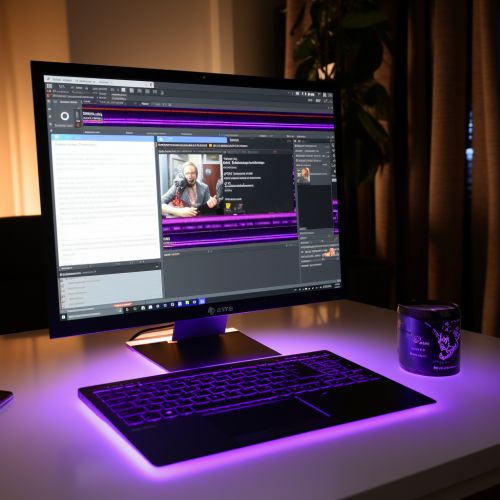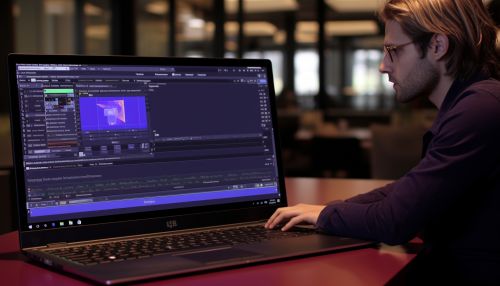Q: Difference between revisions
(Created page with "== Introduction == The letter "Q" is the 17th letter of the modern English alphabet and the ISO basic Latin alphabet. Its name in English is spelled cue, occasionally spelled cu when used in discussions of phonetics and phonology. "Q" is a consonant, with a variety of uses in different languages and in various contexts in English. This article will delve into the history, usage, and significance of the letter "Q" in the English language and beyond. == History == The let...") |
No edit summary |
||
| Line 1: | Line 1: | ||
== | == Overview == | ||
[[Q#]] is a domain-specific [[programming language]] used for expressing [[quantum algorithms]]. It was developed by [[Microsoft]] as part of the Quantum Development Kit to work with their quantum computing efforts. Q# is integrated with [[Visual Studio]], a popular integrated development environment (IDE). | |||
[[Image:Detail-46867.jpg|thumb|center|Screenshot of Q# code in Visual Studio|class=only_on_mobile]] | |||
[[Image:Detail-46868.jpg|thumb|center|Screenshot of Q# code in Visual Studio|class=only_on_desktop]] | |||
== Design == | |||
Q# is designed to be used with a classical host program and can call functions from the host program. It is deeply integrated with the .NET Core Framework. It also includes a comprehensive standard library. | |||
== Syntax == | |||
Q# has a C-style syntax, which is familiar to many programmers. It supports a variety of data types, including Qubits, which are the fundamental unit of quantum information. | |||
== Quantum Computing Concepts in Q# == | |||
Q# introduces quantum computing concepts in a way that is accessible to developers without a background in quantum physics. These concepts include superposition, entanglement, and quantum teleportation. | |||
== | == Quantum Development Kit == | ||
The | The Quantum Development Kit is a set of tools developed by Microsoft to help developers learn to program quantum computers. It includes Q#, a quantum simulator, and other resources. | ||
== Quantum Simulator == | |||
The Quantum Simulator is a tool that allows developers to test and debug their Q# applications. It simulates the behavior of a quantum computer, allowing developers to see how their programs will run on a real quantum machine. | |||
== Quantum Algorithms == | |||
Q# is used to express quantum algorithms. These algorithms can solve certain problems more efficiently than classical algorithms. | |||
== | == Quantum Libraries == | ||
Q# includes libraries for quantum computing. These libraries provide operations, functions, and user-defined types that can be used to build quantum algorithms. | |||
== Integration with Other Languages == | |||
Q# can be used in conjunction with classical programming languages like [[C#]] and [[Python]]. This allows developers to leverage their existing skills while learning to program quantum computers. | |||
== Future of Q# == | |||
As quantum computing continues to advance, Q# is likely to play a key role in the development of quantum applications. | |||
== See Also == | == See Also == | ||
* [[ | * [[Quantum computing]] | ||
* [[ | * [[Quantum algorithm]] | ||
* [[ | * [[Quantum teleportation]] | ||
* [[ | * [[Quantum entanglement]] | ||
* [[ | * [[Superposition principle]] | ||
[[Category: | [[Category:Programming languages]] | ||
[[Category: | [[Category:Quantum computing]] | ||
[[Category: | [[Category:Microsoft software]] | ||
Latest revision as of 10:49, 12 December 2023
Overview
Q# is a domain-specific programming language used for expressing quantum algorithms. It was developed by Microsoft as part of the Quantum Development Kit to work with their quantum computing efforts. Q# is integrated with Visual Studio, a popular integrated development environment (IDE).


Design
Q# is designed to be used with a classical host program and can call functions from the host program. It is deeply integrated with the .NET Core Framework. It also includes a comprehensive standard library.
Syntax
Q# has a C-style syntax, which is familiar to many programmers. It supports a variety of data types, including Qubits, which are the fundamental unit of quantum information.
Quantum Computing Concepts in Q#
Q# introduces quantum computing concepts in a way that is accessible to developers without a background in quantum physics. These concepts include superposition, entanglement, and quantum teleportation.
Quantum Development Kit
The Quantum Development Kit is a set of tools developed by Microsoft to help developers learn to program quantum computers. It includes Q#, a quantum simulator, and other resources.
Quantum Simulator
The Quantum Simulator is a tool that allows developers to test and debug their Q# applications. It simulates the behavior of a quantum computer, allowing developers to see how their programs will run on a real quantum machine.
Quantum Algorithms
Q# is used to express quantum algorithms. These algorithms can solve certain problems more efficiently than classical algorithms.
Quantum Libraries
Q# includes libraries for quantum computing. These libraries provide operations, functions, and user-defined types that can be used to build quantum algorithms.
Integration with Other Languages
Q# can be used in conjunction with classical programming languages like C# and Python. This allows developers to leverage their existing skills while learning to program quantum computers.
Future of Q#
As quantum computing continues to advance, Q# is likely to play a key role in the development of quantum applications.
